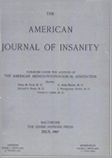THE ORGANIC BACKGROUND OF OBSESSIONS AND COMPULSIONS
Abstract
1. Seven cases of obsession neurosis are presented in which definite organic signs were disclosed by neurological examination. These signs remind of symptoms observed in epidemic encephalitis. However, it is not probable that one deals in these cases with mild encephalitis, of the epidemic type. They may be due to constitutional factors and to early traumatic toxic and infectious processes.
2. In two cases, the type of motility and activity hinted to similar organic factors. In other cases, the psychic symptomatology pointed to an underlying motor impulse disturbance.
3. Compulsion neurosis cases of this type show a particular relation to numbers and counting. There is the tendency to iteration and compulsions based upon it. The attitude towards space is changed. The motor drives are in close relation to sadistic attitudes.
4. Similar disturbances and a similar psychic symptomatology are present in the obsessions and compulsions observed in post encephalitic cases in which the organic change in the motor impulses is obvious.
5. Organic factors influencing the state of consciousness may have an influence in some obsession neurotic cases.
6. Psychotherapy has to consider the importance of the motor factors in compulsions and their relations to sadistic attitudes. They have to be appreciated in connection with the libidinous situation. In the majority of the cases treated, good results were obtained.
Access content
To read the fulltext, please use one of the options below to sign in or purchase access.- Personal login
- Institutional Login
- Sign in via OpenAthens
- Register for access
-
Please login/register if you wish to pair your device and check access availability.
Not a subscriber?
PsychiatryOnline subscription options offer access to the DSM-5 library, books, journals, CME, and patient resources. This all-in-one virtual library provides psychiatrists and mental health professionals with key resources for diagnosis, treatment, research, and professional development.
Need more help? PsychiatryOnline Customer Service may be reached by emailing [email protected] or by calling 800-368-5777 (in the U.S.) or 703-907-7322 (outside the U.S.).



